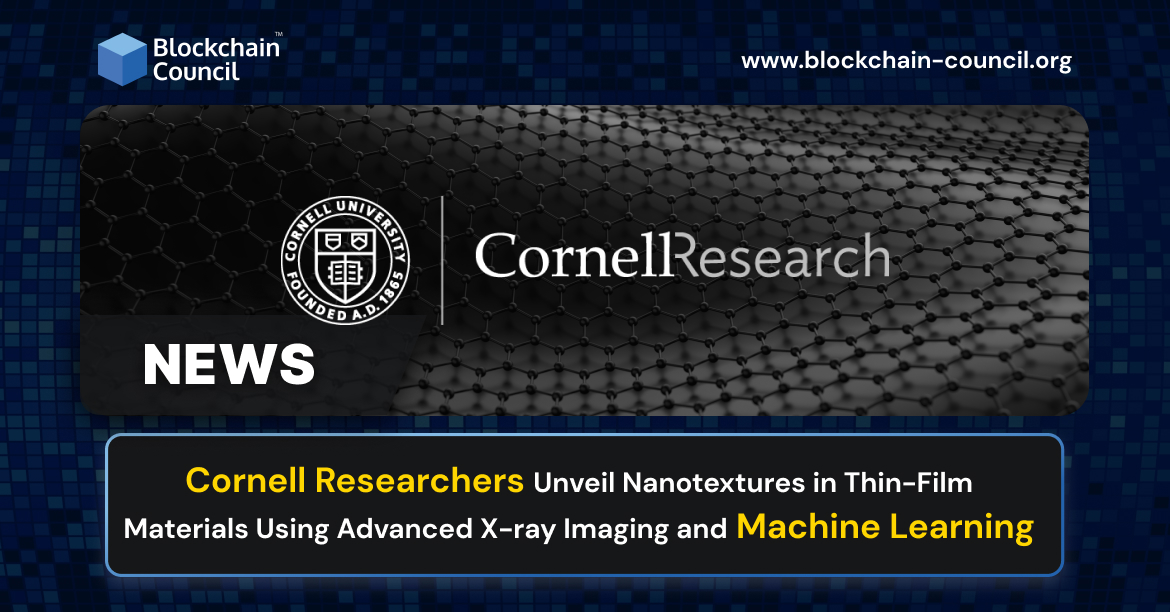
- Blockchain Council
- July 14, 2023
Cornell University scientists have made a groundbreaking discovery in the field of material analysis, employing a unique combination of high-powered X-rays, phase-retrieval algorithms, and machine learning. This innovative approach allows researchers to uncover intricate nanotextures present in thin-film materials, offering a streamlined method for analyzing potential candidates in various applications, including quantum computing and microelectronics.
The study of nanotextures, particularly those distributed non-uniformly throughout a thin film, has attracted significant attention from scientists due to the novel properties they can confer on materials. However, visualizing these nanotextures directly has proven to be a complex challenge that typically involves intricate electron microscopy techniques, which unfortunately do not preserve the sample.
In a recent publication in the Proceedings of the National Academy of Sciences, the Cornell research team detailed a new imaging technique that overcomes these obstacles. By utilizing phase retrieval and machine learning algorithms, they were able to convert conventionally collected X-ray diffraction data, such as that acquired at the Cornell High Energy Synchrotron Source, into real-space visualizations of nanoscale materials.
Also read: Machine Learning in Finance: All You Need to Know
One of the key advantages of this approach is its accessibility to scientists. The use of X-ray diffraction enables imaging of larger portions of the sample, providing a more representative depiction of the material’s true state. Andrej Singer, Assistant Professor of Materials Science and Engineering and David Croll Sesquicentennial Faculty Fellow in Cornell Engineering, who spearheaded the research alongside doctoral student Ziming Shao, highlighted the importance of imaging a large area, stating, “The nanotexture measured by a local probe could depend on the choice of the probed spot.”
Moreover, the new method offers the advantage of non-destructive analysis, eliminating the need to break apart the sample. This breakthrough enables dynamic studies of thin films, allowing researchers to introduce light and observe how structures evolve over time. Shao emphasized the potential applications of this technique, stating, “This method can be readily applied to study dynamics in-situ or operando. For example, we plan to use the method to study how the structure changes within picoseconds after excitation with short laser pulses, which might enable new concepts for future terahertz technologies.”
To validate the imaging results, the researchers tested the technique on two thin films. The first film possessed a known nanotexture, serving as a benchmark for comparison. However, the most intriguing discovery came when they examined a second thin film—a Mott insulator with physics associated with superconductivity. In this case, they observed a previously unseen morphology—a strain-induced nanopattern that spontaneously forms during the cooling process to cryogenic temperatures.
Also read: Google & Machine Learning-Powered Dashboard Protects APIs from Sneaky Attacks
Remarkably, the imaging process does not require any prior knowledge about the sample. Shao emphasized the significance of this breakthrough, stating, “The images are extracted without prior knowledge, potentially setting new benchmarks and informing novel physical hypotheses in phase-field modeling, molecular dynamics simulations, and quantum mechanical calculations.”
The research team included esteemed co-authors, such as the late Lena Kourkoutis, Associate Professor of Applied and Engineering Physics; Kyle Shen, the James A. Weeks Professor of Physical Sciences in the College of Arts and Sciences; Darrell Schlom, the Herbert Fisk Johnson Professor of Industrial Chemistry and Tisch University Professor in the Department of Materials Science and Engineering; and Hari Nair, Assistant Research Professor of Materials Science and Engineering.
This groundbreaking research was made possible with the support of the U.S. Department of Energy and the National Science Foundation. The Cornell researchers’ pioneering work in visualizing nanotextures in thin-film materials has paved the way for a new era of material analysis. By harnessing the power of X-ray imaging, phase retrieval algorithms, and machine learning, scientists can now explore the intricate world of nanoscale materials with unprecedented ease and accuracy. This breakthrough holds immense potential for advancements in quantum computing, microelectronics, and various other technological fields. As researchers continue to unlock the secrets of nanotextures, the possibilities for innovative material design and discovery are limitless.
Also read: AI Interview QnA PDF





































































 Guides
Guides News
News Blockchain
Blockchain Cryptocurrency
& Digital Assets
Cryptocurrency
& Digital Assets Web3
Web3 Metaverse & NFTs
Metaverse & NFTs
